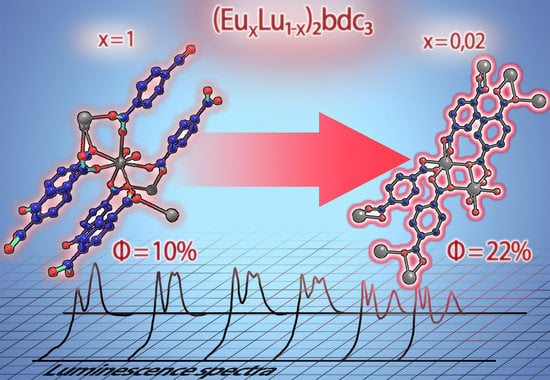Heterometallic Europium(III)–Lutetium(III) Terephthalates as Bright Luminescent Antenna MOFs
Abstract
:1. Introduction
2. Results and Discussion
2.1. XRD Results and Analysis
2.2. Thermogravimetric Analysis (TGA)
2.3. Luminescent Properties
3. Materials and Methods
4. Conclusions
Author Contributions
Funding
Institutional Review Board Statement
Informed Consent Statement
Data Availability Statement
Acknowledgments
Conflicts of Interest
Sample Availability
References
- Xia, T.; Zhang, J. Our Journey of Developing Dual-emitting Metal-organic Framework-based Fluorescent Sensors. Z. Anorg. Allg. Chem. 2022, 648, e202100355. [Google Scholar] [CrossRef]
- Han, X.; Liu, J.; Yu, K.; Lu, Y.; Xiang, W.; Zhao, D.; He, Y. Water-Stable Eu 6 -Cluster-Based Fcu-MOF with Exposed Vinyl Groups for Ratiometric and Fluorescent Visual Sensing of Hydrogen Sulfide. Inorg. Chem. 2022, 61, 5067–5075. [Google Scholar] [CrossRef]
- Zhao, D.; Yu, K.; Han, X.; He, Y.; Chen, B. Recent Progress on Porous MOFs for Process-Efficient Hydrocarbon Separation, Luminescent Sensing, and Information Encryption. Chem. Commun. 2022, 58, 747–770. [Google Scholar] [CrossRef] [PubMed]
- Bryleva, Y.A.; Artem’ev, A.V.; Glinskaya, L.A.; Rakhmanova, M.I.; Samsonenko, D.G.; Komarov, V.Y.; Rogovoy, M.I.; Davydova, M.P. Bright Photo- and Triboluminescence of Centrosymmetric Eu(Iii) and Tb(Iii) Complexes with Phosphine Oxides Containing Azaheterocycles. New J. Chem. 2021, 45, 13869–13876. [Google Scholar] [CrossRef]
- Binnemans, K. Interpretation of Europium(III) Spectra. Coord. Chem. Rev. 2015, 295, 1–45. [Google Scholar] [CrossRef]
- Kozlov, M.I.; Aslandukov, A.N.; Vashchenko, A.A.; Medvedko, A.V.; Aleksandrov, A.E.; Grzibovskis, R.; Goloveshkin, A.S.; Lepnev, L.S.; Tameev, A.R.; Vembris, A.; et al. On the Development of a New Approach to the Design of Lanthanide-Based Materials for Solution-Processed OLEDs. Dalton Trans. 2019, 48, 17298–17309. [Google Scholar] [CrossRef]
- Shurygin, A.V.; Vovna, V.I.; Korochentsev, V.V.; Mirochnik, A.G.; Kalinovskaya, I.V.; Sergienko, V.I. Optical Properties and Electronic Structure of Eu(III) Complexes with HMPA and TPPO. Spectrochim. Acta A Mol. Biomol. Spectrosc. 2021, 250, 119397. [Google Scholar] [CrossRef]
- Khudoleeva, V.; Tcelykh, L.; Kovalenko, A.; Kalyakina, A.; Goloveshkin, A.; Lepnev, L.; Utochnikova, V. Terbium-Europium Fluorides Surface Modified with Benzoate and Terephthalate Anions for Temperature Sensing: Does Sensitivity Depend on the Ligand? J. Lumin. 2018, 201, 500–508. [Google Scholar] [CrossRef]
- Zhou, X.; Wang, H.; Jiang, S.; Xiang, G.; Tang, X.; Luo, X.; Li, L.; Zhou, X. Multifunctional Luminescent Material Eu(III) and Tb(III) Complexes with Pyridine-3,5-Dicarboxylic Acid Linker: Crystal Structures, Tunable Emission, Energy Transfer, and Temperature Sensing. Inorg. Chem. 2019, 58, 3780–3788. [Google Scholar] [CrossRef]
- Liu, D.; Lu, K.; Poon, C.; Lin, W. Metal-Organic Frameworks as Sensory Materials and Imaging Agents. Inorg. Chem. 2014, 53, 1916–1924. [Google Scholar] [CrossRef]
- Panikar, S.S.; Ramírez-García, G.; Vallejo-Cardona, A.A.; Banu, N.; Patrón-Soberano, O.A.; Cialla-May, D.; Camacho-Villegas, T.A.; de La Rosa, E. Novel Anti-HER2 Peptide-Conjugated Theranostic Nanoliposomes Combining NaYF4:Yb,Er Nanoparticles for NIR-Activated Bioimaging and Chemo-Photodynamic Therapy against Breast Cancer. Nanoscale 2019, 11, 20598–20613. [Google Scholar] [CrossRef]
- Liu, H.; Lu, W.; Wang, H.; Rao, L.; Yi, Z.; Zeng, S.; Hao, J. Simultaneous Synthesis and Amine-Functionalization of Single-Phase BaYF5:Yb/Er Nanoprobe for Dual-Modal In Vivo Upconversion Fluorescence and Long-Lasting X-ray Computed Tomography Imaging. Nanoscale 2013, 5, 6023–6029. [Google Scholar] [CrossRef] [PubMed]
- Shen, T.; Zhang, Y.; Kirillov, A.M.; Hu, B.; Shan, C.; Liu, W.; Tang, Y. Versatile Rare-Earth Oxide Nanocomposites: Enhanced Chemo/Photothermal/Photodynamic Anticancer Therapy and Multimodal Imaging. J. Mater. Chem. B 2016, 4, 7832–7844. [Google Scholar] [CrossRef] [PubMed]
- Liu, W.; Yin, R.; Xu, X.; Zhang, L.; Shi, W.; Cao, X. Structural Engineering of Low-Dimensional Metal–Organic Frameworks: Synthesis, Properties, and Applications. Adv. Sci. 2019, 6, 1802373. [Google Scholar] [CrossRef] [PubMed]
- Ryu, U.J.; Jee, S.; Rao, P.C.; Shin, J.; Ko, C.; Yoon, M.; Park, K.S.; Choi, K.M. Recent Advances in Process Engineering and Upcoming Applications of Metal–Organic Frameworks. Coord. Chem. Rev. 2021, 426, 213544. [Google Scholar] [CrossRef] [PubMed]
- Cook, T.R.; Zheng, Y.R.; Stang, P.J. Metal-Organic Frameworks and Self-Assembled Supramolecular Coordination Complexes: Comparing and Contrasting the Design, Synthesis, and Functionality of Metal-Organic Materials. Chem. Rev. 2013, 113, 734–777. [Google Scholar] [CrossRef] [PubMed]
- Puglisi, R.; Pellegrino, A.L.; Fiorenza, R.; Scirè, S.; Malandrino, G. A Facile One-Pot Approach to the Synthesis of Gd-Eu Based Metal-Organic Frameworks and Applications to Sensing of Fe3+ and Cr2O72− Ions. Sensors 2021, 21, 1679. [Google Scholar] [CrossRef]
- Lustig, W.P.; Mukherjee, S.; Rudd, N.D.; Desai, A.V.; Li, J.; Ghosh, S.K. Metal-Organic Frameworks: Functional Luminescent and Photonic Materials for Sensing Applications. Chem. Soc. Rev. 2017, 46, 3242–3285. [Google Scholar] [CrossRef]
- Liu, D.; Dong, G.; Wang, X.; Nie, F.; Li, X. A Luminescent Eu Coordination Polymer with Near-Visible Excitation for Sensing and Its Homologues Constructed from 1,4-Benzenedicarboxylate and 1: H-Imidazo[4,5-f] [1,10]-Phenanthroline. CrystEngComm 2020, 22, 7877–7887. [Google Scholar] [CrossRef]
- Ding, S.B.; Wang, W.; Qiu, L.G.; Yuan, Y.P.; Peng, F.M.; Jiang, X.; Xie, A.J.; Shen, Y.H.; Zhu, J.F. Surfactant-Assisted Synthesis of Lanthanide Metal-Organic Framework Nanorods and Their Fluorescence Sensing of Nitroaromatic Explosives. Mater. Lett. 2011, 65, 1385–1387. [Google Scholar] [CrossRef]
- Zhao, J.J.; Liu, P.Y.; Dong, Z.P.; Liu, Z.L.; Wang, Y.Q. Eu(III)-Organic Framework as a Multi-Responsive Photoluminescence Sensor for Efficient Detection of 1-Naphthol, Fe3+ and MnO4− in Water. Inorg. Chim. Acta 2020, 511, 119843. [Google Scholar] [CrossRef]
- Han, X.; Gu, C.; Ding, Y.; Yu, J.; Li, K.; Zhao, D.; Chen, B. Stable Eu3+/Cu2+-Functionalized Supramolecular Zinc(II) Complexes as Fluorescent Probes for Turn-On and Ratiometric Detection of Hydrogen Sulfide. ACS Appl. Mater. Interfaces 2021, 13, 20371–20379. [Google Scholar] [CrossRef] [PubMed]
- Dong, C.L.; Li, M.F.; Yang, T.; Feng, L.; Ai, Y.W.; Ning, Z.L.; Liu, M.J.; Lai, X.; Gao, D.J. Controllable Synthesis of Tb-Based Metal–Organic Frameworks as an Efficient Fluorescent Sensor for Cu2+ Detection. Rare Met. 2021, 40, 505–512. [Google Scholar] [CrossRef]
- Nguyen, L.H.; Oveissi, F.; Chandrawati, R.; Dehghani, F.; Naficy, S. Naked-Eye Detection of Ethylene Using Thiol-Functionalized Polydiacetylene-Based Flexible Sensors. ACS Sens. 2020, 5, 1921–1928. [Google Scholar] [CrossRef]
- Feng, L.; Dong, C.; Li, M.; Li, L.; Jiang, X.; Gao, R.; Wang, R.; Zhang, L.; Ning, Z.; Gao, D.; et al. Terbium-Based Metal-Organic Frameworks: Highly Selective and Fast Respond Sensor for Styrene Detection and Construction of Molecular Logic Gate. J. Hazard. Mater. 2020, 388, 121816. [Google Scholar] [CrossRef]
- Janicki, R.; Mondry, A.; Starynowicz, P. Carboxylates of Rare Earth Elements. Coord. Chem. Rev. 2017, 340, 98–133. [Google Scholar] [CrossRef]
- Utochnikova, V.V.; Kuzmina, N.P. Photoluminescence of Lanthanide Aromatic Carboxylates. Russ. J. Coord. Chem. 2016, 42, 679–694. [Google Scholar] [CrossRef]
- Cao, W.; Tang, Y.; Cui, Y.; Qian, G. Energy Transfer in Metal–Organic Frameworks and Its Applications. Small Struct. 2020, 1, 2000019. [Google Scholar] [CrossRef]
- Yin, H.Q.; Wang, X.Y.; Yin, X.B. Rotation Restricted Emission and Antenna Effect in Single Metal-Organic Frameworks. J. Am. Chem. Soc. 2019, 141, 15166–15173. [Google Scholar] [CrossRef]
- Do Nascimento, J.F.S.; Barros, B.S.; Kulesza, J.; de Oliveira, J.B.L.; Pereira Leite, A.K.; de Oliveira, R.S. Influence of Synthesis Time on the Microstructure and Photophysical Properties of Gd-MOFs Doped with Eu3+. Mater. Chem. Phys. 2017, 190, 166–174. [Google Scholar] [CrossRef]
- Kolesnik, S.S.; Nosov, V.G.; Kolesnikov, I.E.; Khairullina, E.M.; Tumkin, I.I.; Vidyakina, A.A.; Sysoeva, A.A.; Ryazantsev, M.N.; Panov, M.S.; Khripun, V.D.; et al. Ultrasound-Assisted Synthesis of Luminescent Micro-and Nanocrystalline Eu-Based Mofs as Luminescent Probes for Heavy Metal Ions. Nanomaterials 2021, 11, 2448. [Google Scholar] [CrossRef] [PubMed]
- Okuno, Y.; Cavagnero, S. Effect of Heavy Atoms on Photochemically Induced Dynamic Nuclear Polarization in Liquids. J. Magn. Reson. 2018, 286, 172–187. [Google Scholar] [CrossRef] [PubMed]
- Cui, G.; Fang, W.H. State-Specific Heavy-Atom Effect on Intersystem Crossing Processes in 2-Thiothymine: A Potential Photodynamic Therapy Photosensitizer. J. Chem. Phys. 2013, 138, 044315. [Google Scholar] [CrossRef]
- Utochnikova, V.V.; Grishko, A.Y.; Koshelev, D.S.; Averin, A.A.; Lepnev, L.S.; Kuzmina, N.P. Lanthanide Heterometallic Terephthalates: Concentration Quenching and the Principles of the “Multiphotonic Emission”. Opt. Mater. 2017, 74, 201–208. [Google Scholar] [CrossRef]
- Bryleva, Y.A.; Ustimenko, Y.P.; Plyusnin, V.F.; Mikheilis, A.V.; Shubin, A.A.; Glinskaya, L.A.; Komarov, V.Y.; Agafontsev, A.M.; Tkachev, A.V. Ln(Iii) Complexes with a Chiral 1H-Pyrazolo[3,4-b]Pyridine Derivative Fused with a (−)-α-Pinene Moiety: Synthesis, Crystal Structure, and Photophysical Studies in Solution and in the Solid State. New J. Chem. 2021, 45, 2276–2284. [Google Scholar] [CrossRef]
- Kolesnikov, I.E.; Vidyakina, A.A.; Vasileva, M.S.; Nosov, V.G.; Bogachev, N.A.; Sosnovsky, V.B.; Skripkin, M.Y.; Tumkin, I.I.; Lähderanta, E.; Mereshchenko, A.S. The Effect of Eu3+ and Gd3+ co-Doping on the Morphology and Luminescence of NaYF4:Eu3+, Gd3+ phosphors. New J. Chem. 2021, 45, 10599–10607. [Google Scholar] [CrossRef]
- Reineke, T.M.; Eddaoudi, M.; Fehr, M.; Kelley, D.; Yaghi, O.M. From Condensed Lanthanide Coordination Solids to Microporous Frameworks Having Accessible Metal Sites. J. Am. Chem. Soc. 1999, 121, 1651–1657. [Google Scholar] [CrossRef]
- Daiguebonne, C.; Kerbellec, N.; Guillou, O.; Bünzli, J.C.; Gumy, F.; Catala, L.; Mallah, T.; Audebrand, N.; Gérault, Y.; Bernot, K.; et al. Structural and Luminescent Properties of Micro- and Nanosized Particles of Lanthanide Terephthalate Coordination Polymers. Inorg. Chem. 2008, 47, 3700–3708. [Google Scholar] [CrossRef]
- Holland, T.J.B.; Redfern, S.A.T. Unit Cell Refinement from Powder Diffraction Data: The Use of Regression Diagnostics. Mineral. Mag. 1997, 61, 65–77. [Google Scholar] [CrossRef]
- Shannon, R.D. Revised Effective Ionic Radii and Systematic Studies of Interatomie Distances in Halides and Chaleogenides. Acta Crystallogr. Sect. A 1976, 32, 751–767. [Google Scholar] [CrossRef]
- Cui, Y.; Yue, Y.; Qian, G.; Chen, B. Luminescent Functional Metal-Organic Frameworks. Chem. Rev. 2012, 112, 1126–1162. [Google Scholar] [CrossRef] [PubMed]
- Alammar, T.; Hlova, I.Z.; Gupta, S.; Biswas, A.; Ma, T.; Zhou, L.; Balema, V.; Pecharsky, V.K.; Mudring, A.V. Mechanochemical Synthesis, Luminescent and Magnetic Properties of Lanthanide Benzene-1,4-Dicarboxylate Coordination Polymers (Ln0.5Gd0.5)2 (1,4-BDC)3(H2O)4; Ln = Sm, Eu, Tb. New J. Chem. 2020, 44, 1054–1062. [Google Scholar] [CrossRef]
- Dieke, G.H.; Crosswhite, H.M. The Spectra of the Doubly and Triply Ionized Rare Earths. Appl. Opt. 1963, 2, 675–686. [Google Scholar] [CrossRef]
- Tanner, P.A. Some Misconceptions Concerning the Electronic Spectra of Tri-Positive Europium and Cerium. Chem. Soc. Rev. 2013, 42, 5090–5101. [Google Scholar] [CrossRef] [PubMed]
- Haquin, V.; Etienne, M.; Daiguebonne, C.; Freslon, S.; Calvez, G.; Bernot, K.; le Pollès, L.; Ashbrook, S.E.; Mitchell, M.R.; Bünzli, J.C.; et al. Color and Brightness Tuning in Heteronuclear Lanthanide Terephthalate Coordination Polymers. Eur. J. Inorg. Chem. 2013, 2013, 3464–3476. [Google Scholar] [CrossRef]
- Li, M.; Zhou, Y.; Yao, Y.; Gao, T.; Yan, P.; Li, H. Designing Water-Quenching Resistant Highly Luminescent Europium Complexes by Regulating the Orthogonal Arrangement of Bis-β-Diketone Ligands. Dalton Trans. 2021, 50, 9914–9922. [Google Scholar] [CrossRef]
- Ivanova, A.A.; Gontcharenko, V.E.; Lunev, A.M.; Sidoruk, A.V.; Arkhipov, I.A.; Taydakov, I.V.; Belousov, Y.A. New Carboxylate Anionic Sm-MOF: Synthesis, Structure and Effect of the Isomorphic Substitution of Sm3+ with Gd3+ and Tb3+ Ions on the Luminescent Properties. Inorganics 2022, 10, 104. [Google Scholar] [CrossRef]
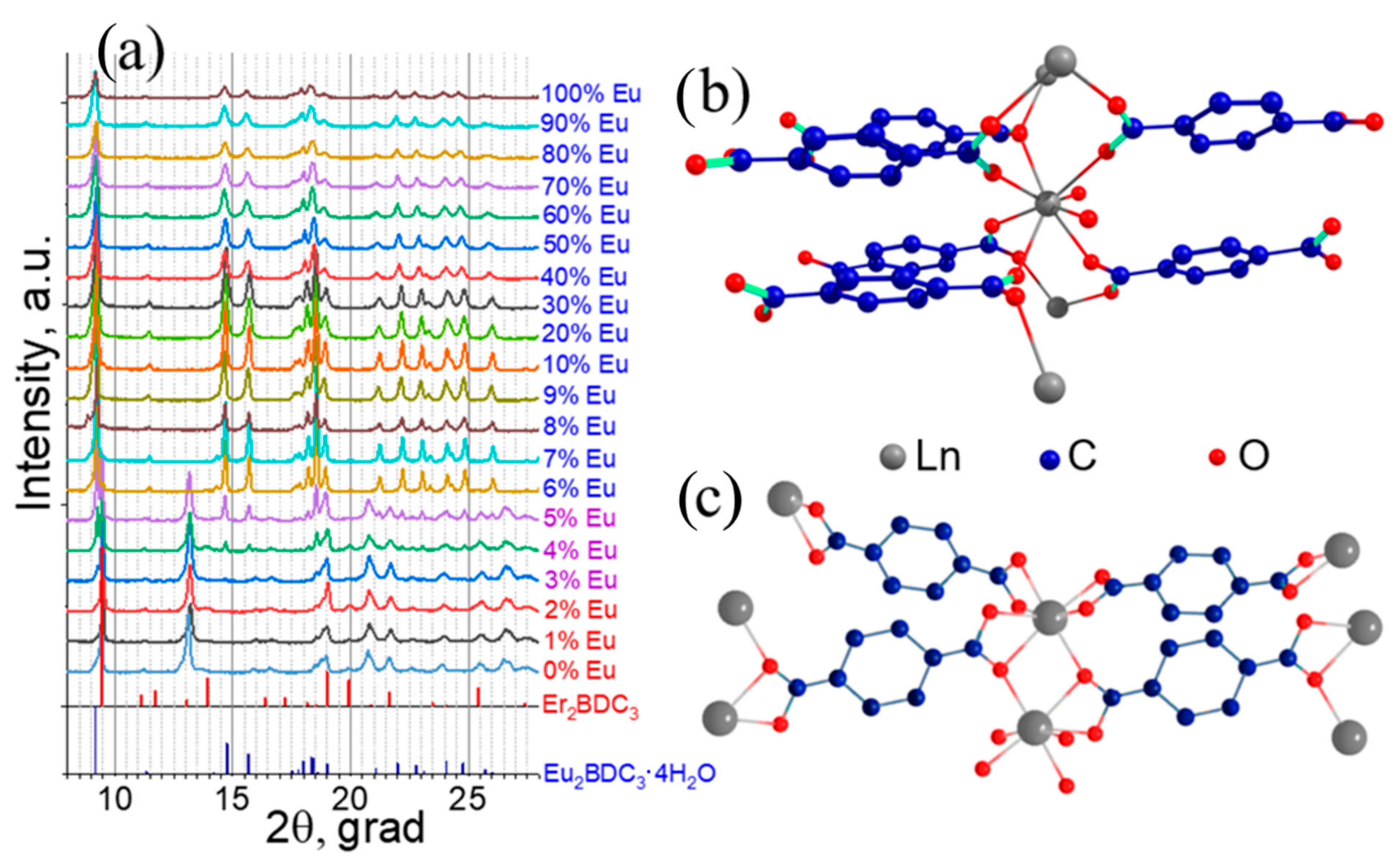
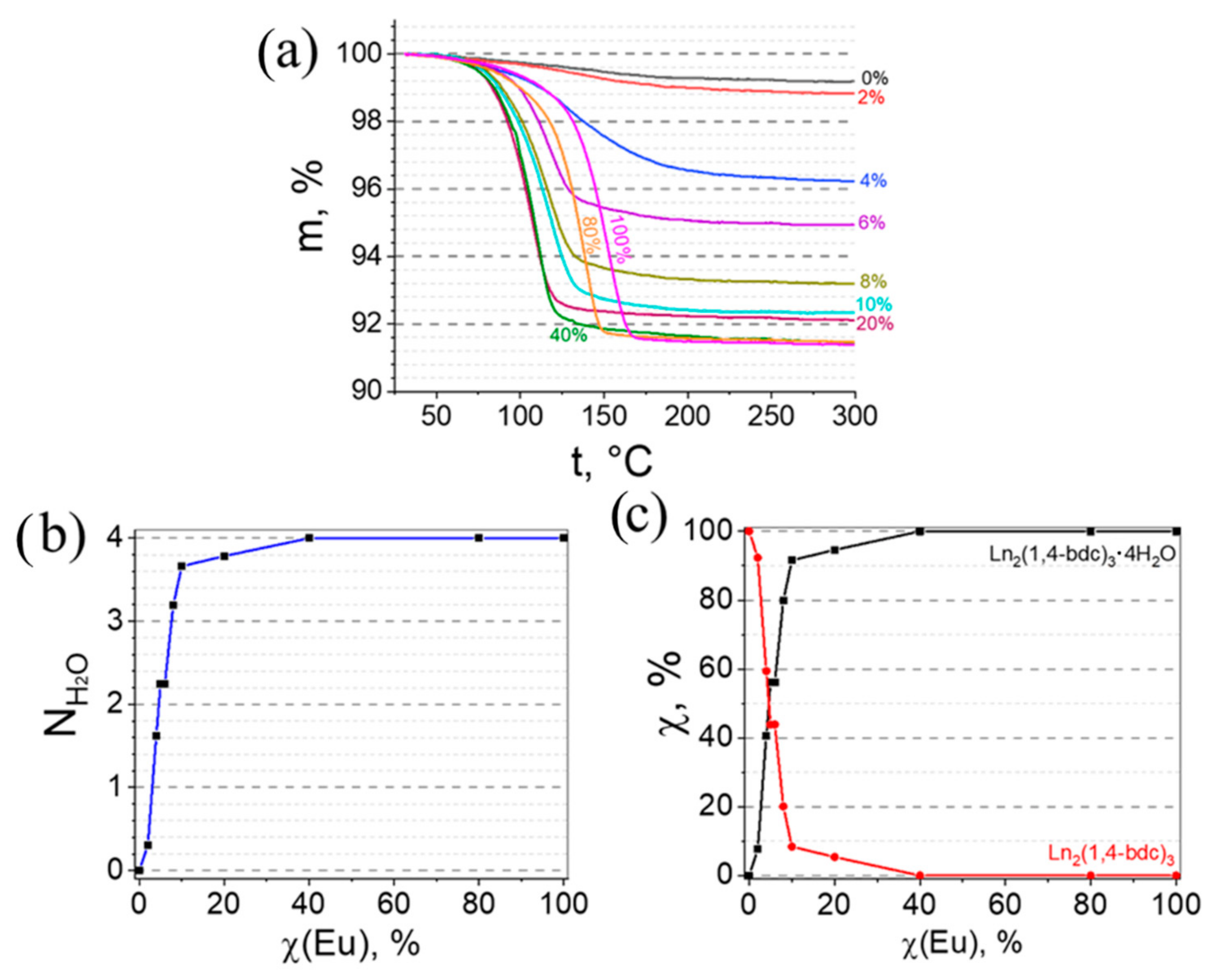
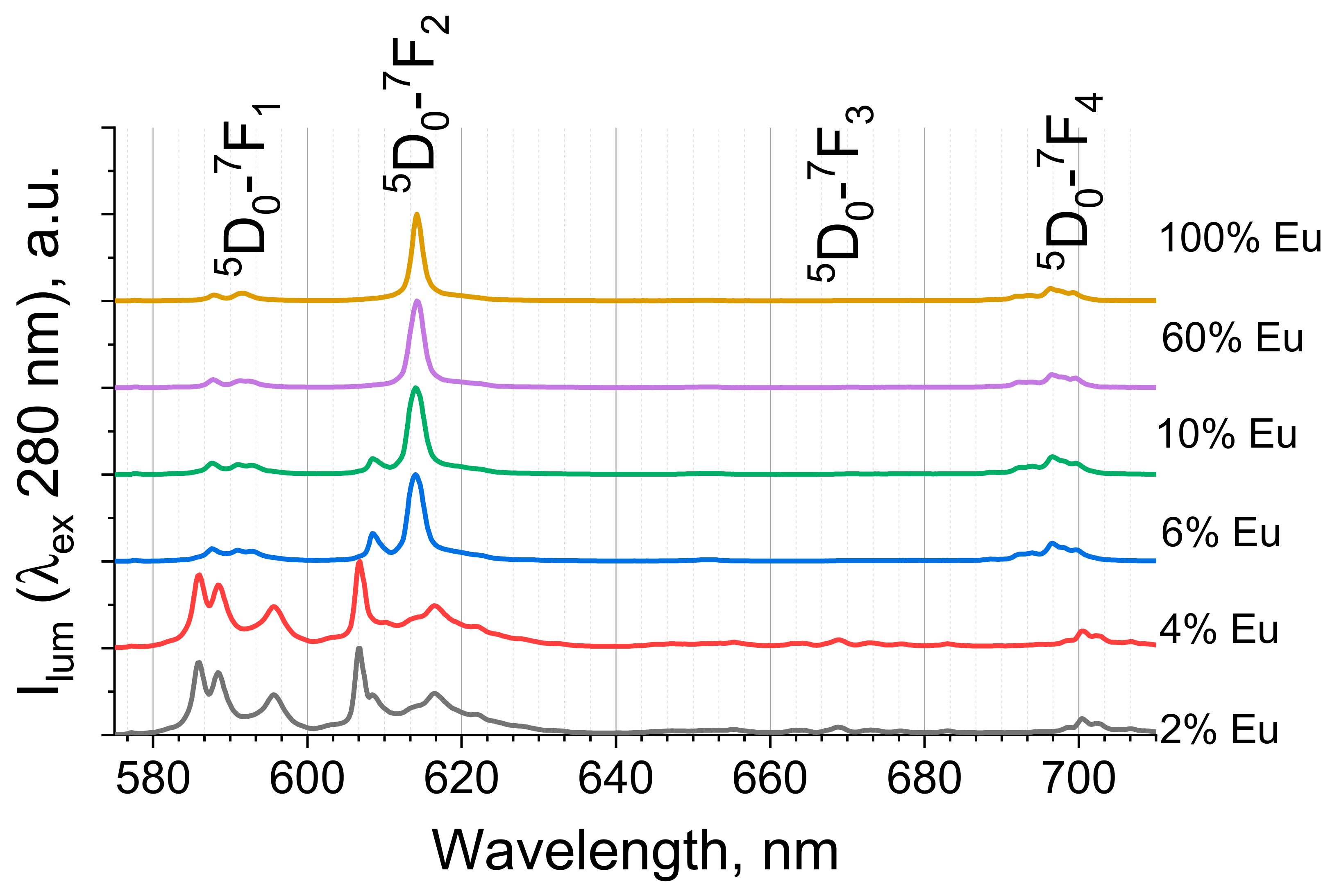
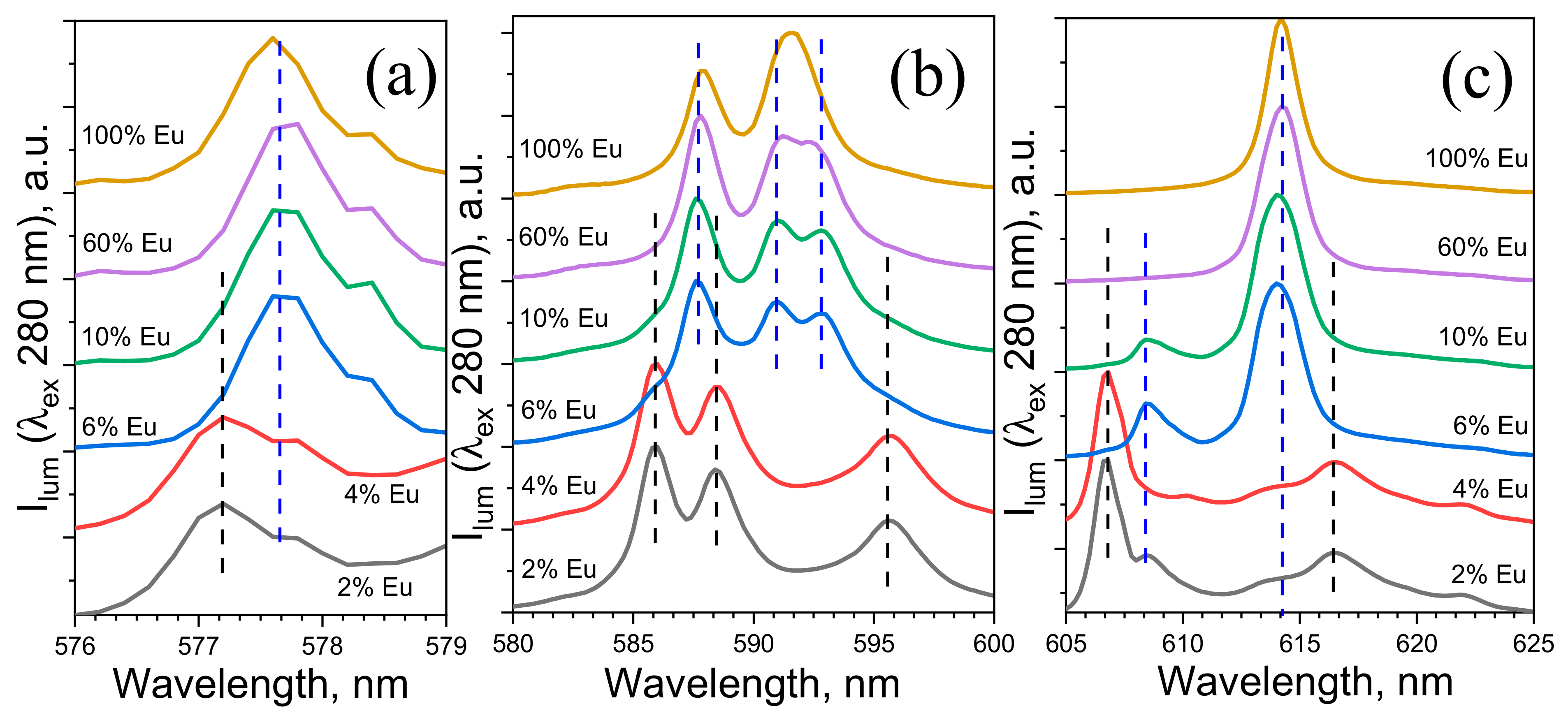
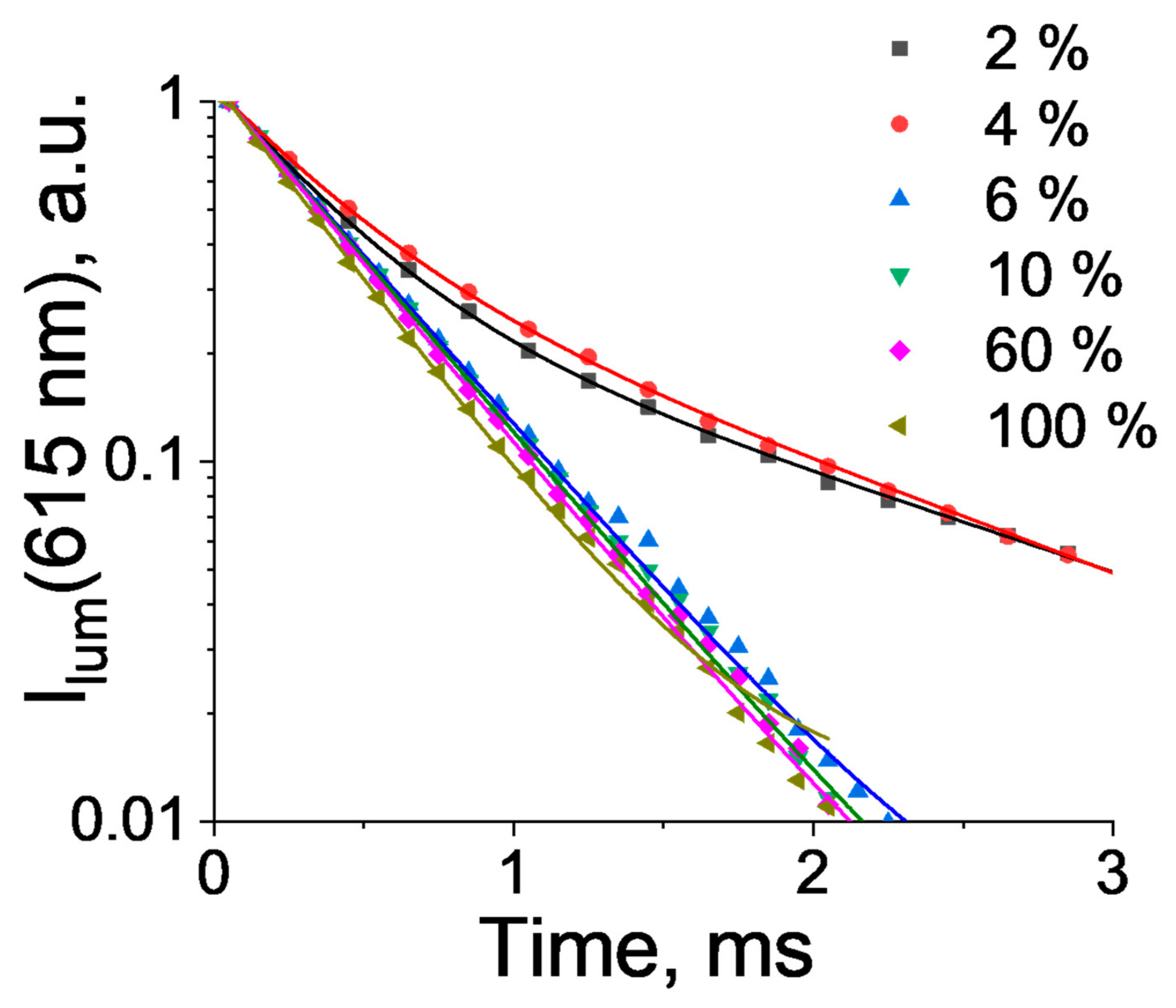
| χEu (%) | a, Å | b, Å | c, Å | α | β | γ | V, Å3 |
|---|---|---|---|---|---|---|---|
| 100 | 6.1904 ±0.0019 | 9.856 ±0.003 | 10.251 ±0.003 | 101.673 ±0.027 | 90.273 ±0.028 | 104.796 ±0.025 | 591.13 ±0.22 |
| 90 | 6.1862 ±0.0019 | 9.845 ±0.003 | 10.236 ±0.003 | 101.583 ±0.027 | 90.300 ±0.028 | 104.727 ±0.025 | 589.63 ±0.22 |
| 60 | 6.1727 ±0.0018 | 9.815 ±0.003 | 10.206 ±0.003 | 101.553 ±0.027 | 90.418 ±0.028 | 104.657 ±0.025 | 585.00 ±0.22 |
| 40 | 6.1635 ±0.0018 | 9.783 ±0.003 | 10.179 ±0.003 | 101.497 ±0.027 | 90.472 ±0.028 | 104.651 ±0.025 | 580.75 ±0.22 |
| 20 | 6.1405 ±0.0018 | 9.738 ±0.003 | 10.145 ±0.003 | 101.570 ±0.027 | 90.562 ±0.028 | 104.617 ±0.025 | 573.90 ±0.21 |
| 10 | 6.1411 ±0.0018 | 9.7178 ±0.003 | 10.1334 ±0.003 | 101.626 ±0.026 | 90.461 ±0.028 | 104.590 ±0.025 | 572.13 ±0.21 |
| 6 | 6.1313 ±0.0018 | 9.714 ±0.003 | 10.130 ±0.003 | 101.582 ±0.026 | 90.474 ±0.027 | 104.608 ±0.025 | 570.784 ±0.21 |
| χEu (%) | τ1, ms | τ2, ms | PLQY, % |
|---|---|---|---|
| 100 | 0.390 | 10 ± 1 | |
| 60 | 0.435 | 11 ± 1 | |
| 10 | 0.449 | 12 ± 1 | |
| 6 | 0.459 | 16 ± 1 | |
| 4 | 0.392 | 1.602 | 22 ± 1 |
| 2 | 0.367 | 1.878 | 22 ± 1 |
| χEu, % | V(0.2M EuCl3), mL | V(0.2M LuCl3), mL |
|---|---|---|
| 0 | 0 | 1.00 |
| 1 | 0.01 | 0.99 |
| 2 | 0.02 | 0.98 |
| 3 | 0.03 | 0.97 |
| 4 | 0.04 | 0.96 |
| 5 | 0.05 | 0.95 |
| 6 | 0.06 | 0.94 |
| 7 | 0.07 | 0.93 |
| 8 | 0.08 | 0.92 |
| 9 | 0.09 | 0.91 |
| 10 | 0.10 | 0.90 |
| 20 | 0.20 | 0.80 |
| 30 | 0.30 | 0.70 |
| 40 | 0.40 | 0.60 |
| 50 | 0.50 | 0.50 |
| 60 | 0.60 | 0.40 |
| 70 | 0.70 | 0.30 |
| 80 | 0.80 | 0.20 |
| 90 | 0.90 | 0.10 |
| 100 | 1.00 | 0 |
| χEu (%), Taken | χEu (%), EDX |
|---|---|
| 0 | 0 |
| 2 | 2.07 ± 0.21 |
| 4 | 3.9 ± 0.4 |
| 5 | 4.7 ± 0.5 |
| 6 | 6.3 ± 0.6 |
| 10 | 10.2 ± 1.0 |
| 20 | 19.3 ± 1.9 |
| 40 | 37 ± 4 |
| 80 | 80 ± 8 |
| 100 | 100 |
Publisher’s Note: MDPI stays neutral with regard to jurisdictional claims in published maps and institutional affiliations. |
© 2022 by the authors. Licensee MDPI, Basel, Switzerland. This article is an open access article distributed under the terms and conditions of the Creative Commons Attribution (CC BY) license (https://creativecommons.org/licenses/by/4.0/).
Share and Cite
Nosov, V.G.; Kupryakov, A.S.; Kolesnikov, I.E.; Vidyakina, A.A.; Tumkin, I.I.; Kolesnik, S.S.; Ryazantsev, M.N.; Bogachev, N.A.; Skripkin, M.Y.; Mereshchenko, A.S. Heterometallic Europium(III)–Lutetium(III) Terephthalates as Bright Luminescent Antenna MOFs. Molecules 2022, 27, 5763. https://doi.org/10.3390/molecules27185763
Nosov VG, Kupryakov AS, Kolesnikov IE, Vidyakina AA, Tumkin II, Kolesnik SS, Ryazantsev MN, Bogachev NA, Skripkin MY, Mereshchenko AS. Heterometallic Europium(III)–Lutetium(III) Terephthalates as Bright Luminescent Antenna MOFs. Molecules. 2022; 27(18):5763. https://doi.org/10.3390/molecules27185763
Chicago/Turabian StyleNosov, Viktor G., Arkady S. Kupryakov, Ilya E. Kolesnikov, Aleksandra A. Vidyakina, Ilya I. Tumkin, Stefaniia S. Kolesnik, Mikhail N. Ryazantsev, Nikita A. Bogachev, Mikhail Yu. Skripkin, and Andrey S. Mereshchenko. 2022. "Heterometallic Europium(III)–Lutetium(III) Terephthalates as Bright Luminescent Antenna MOFs" Molecules 27, no. 18: 5763. https://doi.org/10.3390/molecules27185763
APA StyleNosov, V. G., Kupryakov, A. S., Kolesnikov, I. E., Vidyakina, A. A., Tumkin, I. I., Kolesnik, S. S., Ryazantsev, M. N., Bogachev, N. A., Skripkin, M. Y., & Mereshchenko, A. S. (2022). Heterometallic Europium(III)–Lutetium(III) Terephthalates as Bright Luminescent Antenna MOFs. Molecules, 27(18), 5763. https://doi.org/10.3390/molecules27185763








